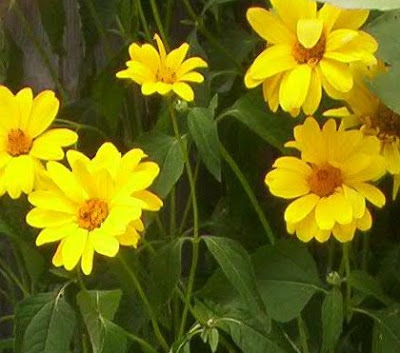

Yeh, the centimeters don't mean anything to me, either. They're about 6" long & 6" across. The really fat one, I need to take a tape measure to it, because I think it's about 10" circumference. These were winter storage carrots that got so darned fat. My other carrots were long and pretty thick, too, but nothing like this! Have a half bushel to slice & freeze this week.
Wednesday, October 8, 2008
Holy Fat Carrots, Batman!
Posted by CannedAm at 12:54 PM 6 comments
Labels: carrot harvest, fat carrots
Monday, September 29, 2008
Gardening Mistakes I Hope Not to Make Next Year
I don't think I want to plant sunflowers near my vegetable garden. Two years in a row they are covered in powdery mildew and spread it on to the other plants. I love the sunflowers, don't get me wrong. I do not like my cucumbers covered in the powdery mildew. I'll see if the city will let me plant them around the telephone pole in the tree lawn. I think they'd be happy there and my veggies will be safe.
Peppers....I'll plant them much earlier next year and start them inside much earlier than I did last year. I think we got started in March. I'll try early February next year so that they're much larger.
Maters....I won't crowd them so much. Though they did fine, it's a real pain to pick them and I think they'll mature more quickly with a bit more space.
Beans....I'm planting more of them, a different variety & I'll have a finch feeder nearby. Those bean beetles really pissed me off.
Nematodes. I'm buying some as early as I can. The kind that eat all the bad nasties hiding in the soil waiting to eat our plants...like those bean beetles. Grrrr.
Better soil in the square foot boxes. I'm not entirely sold on Mel's Mix though I might have to try it in one box just for comparison. I don't like the idea of using Peat Moss so heavily. Despite what the Canadian government says about our Peat Moss supplies being perfectly fine...it's still a limited resource and what kind of damage are we doing to the environments from which we strip it?
I'll use more of my front flower beds for vegetables. I have plans, oh I have plans. I had tomatoes out there this year and they tasted amazing being next to a garden oregano plant. Just wonderful. Now I'll plant a few more things out there.
I'm sure there's more, but that's all I can think of for now.
Sorry for the long absence. Gardening has been kind of sucky recently, plus my camera was broken so....no pictures.
Posted by CannedAm at 11:29 PM 4 comments
Labels: garden mistakes, garden planning, grow food not grass
Sunday, August 31, 2008
Chinese Lantern Harvest
Posted by CannedAm at 9:00 AM 6 comments
Labels: Chinese Lantern plant, drying flowers, How to dry Chinese Lanterns
Saturday, August 30, 2008
SON OF A BEAN BEETLE!
So I went out to harvest beans yesterday and guess what I found?
You know what those fat, yellow, fuzzy suckers are? Mexican Bean Beetle larva. And they seem to have prodigious appetites.
While harvesting beans from my bush plants (barely any nibbles on those plants) I noticed that the leaves of the bean tee pee were looking much more chewed than they had previously. Previously I found only two adult beetles on the tee pee. It seemed almost immune. Not so, obviously.
The Mexican Bean Beetle is the black sheep of the ladybug family. Ladybugs eat other damaging bugs in our gardens, but the Mexican Bean Beetle likes to chomp on bean leaves (and the beans, too!) RJ, my nine-year-old, was most upset when he thought I was drowning ladybugs. Here is what the adults look like. (Most of mine have been bright red, but some were paler yellow-orange).

 I know my picture of the larva is rather hard to see, so here's a much better picture I found on the 'net:
I know my picture of the larva is rather hard to see, so here's a much better picture I found on the 'net:
My shoulders are actually sore from picking these suckers off my bean leaves and drowning them. There were SO MANY of them! I know there are more, but my soreness turned into a pinched nerve and ended my bug harvest. Hubby's out picking them now. I don't know why the beetles decided to go and lay their eggs on my tee pee plants since those were not the plants with the most beetles on them. I guess they figured there wasn't much eating left on the other bean plants.
Relatively few of the beans were damaged. I picked about 4 quarts and tossed only a handful, so at least they're not overly damaging the harvest. I understand later in the season they will go after the beans more.
I had sprinkled the leaves with diatomaceous earth, but it seemed to do nothing to deter the nasty bugs. Next year (it's too late this year) I could order the spined soldier bug from Natural Insect Control, a local company. They're rather expensive for the small number of plants in my home garden, though. I can also erect finch feeders near my bean plants, which is what I will most likely do. Finches will happily snack on Mexican Bean Beetles. I will continue to handpick and drown (in soapy water) the adults and larva I find. I could also try to find a supplier for the parisitic wasp Pediobius foveolatus. Price is a factor. I truly cannot afford to spend $100 on bugs to kill bugs in my garden, nor would I need as many as $100 would buy. That kind of expenditure completely negates the frugality of home gardening.
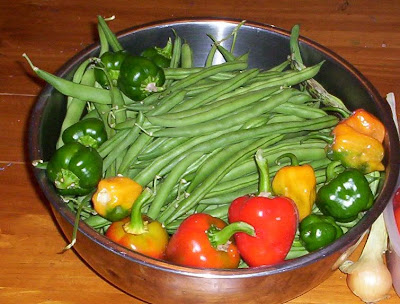
Posted by CannedAm at 8:00 AM 1 comments
Labels: bean harvest, beneficial insects, bugs on bean plants, mexican bean beetle, yellow fuzzy bugs on bean plants
Thursday, August 28, 2008
Is Your Garden Addicted to Miracle-Gro?
Did you ever use it and have wonderful results, then the next year not use it and have terrible results?
Well, here's why...Miracle-Gro and other synthetic fertilizers strip the soil of nutrients. Wash them right out. It also salinates the soil (salts the earth) and makes it a very unfriendly place to nematodes, worms, and other critters that break down organic wastes and feed the soil and plant roots around them. The processes by which synthetic fertilizers are made is extremely hard on the environment. Those processes use incredible amounts of energy and create enormous amounts of waste.
Synthetic fertilizers only consider the three big nutrients for plants: Nitrogen (N), Phosphorous (P), and Potassium (K). Putting plants on a synthetic fertilizer diet is like putting a person on a diet that ONLY contains Protein, Carbohydrates and Fat --- no iron, vitamin C, magnesium, etc., just the big 3 macronutrients. Everyone knows we need more than just protein, carbs, and fat. So do plants. Calcium deficiency shows up in some plants as black roots, pale leaf margins and, in tomatoes, blossom-end rot.
Synthetic fertilizers are short acting and water soluble. Meaning only about 15% of what you add to your soil is used by the plants and the rest is rinsed away with the rain. Synthetic fertilizers are to blame for nitrates in our drinking water.
I suspect a lot of people think that synthetic fertilizers (like Miracle-Gro) are vitamins for plants. Since chemical fertilizers strip soils of the natural nutrients that plants need, soils and the plants grown in them become dependent upon those chemical fertilizers. That really makes synthetic fertilizers more like a drug than a vitamin and their relationship with soil and plants an addictive one. The synthetic fertilizers have to continually be added to the soil in order to feed the plants the nutrients they need. Why? because those fertilizers denude the soils their beneficial nutrients and organisms. It's kind of like a human taking speed to get a bit of oomph instead of eating a piece of fruit for the same oomph. Studies have also shown that synthetic fertilizers actually REDUCE the nutritional value of fruits and vegetable grown using them. How's that for a drug?!
What is preferable is organic fertilizer. There are about a million different kinds. Bacteria dwelling in the soil will fix nitrogen out of the air into the soil for plants to use. That bacteria will be present if it hasn't been killed off by synthetic fertilizer use. Certain plants are better at fixing nitrogen than others. Clovers and all legumes are nitrogen fixers. They suck enormous amounts of nitrogen from the air and store it in the soil for future plants to use. Phosphorous can be gotten from crushed phosphate rock, bone meal, dried blood, cottonseed meal and other sources. Potassium (potash) can be gotten from plant residues (in the form of wood ash), manures & compost and natural mineral sources such as granite dust, greensand and basalt rock. Seaweed and seaweed extract are also excellent sources of potash.
Soil really needs to be viewed as a living organism requiring a wide range of nutrients in order to support the many life forms within it-- from plants to worms and bacteria to fungus. I use compost, manure, mulch, wood ash, nitrogen-fixing plants, seaweed extract and fish emulsions to feed my plants and nourish my soil. The great thing about any of these is that they can stay resident in the soil for future generations to use and do not convert to toxins in the soil or pollute our waters. That's conscientious gardening. I purchase my seaweed extract and fish emulsion from Stokes.
I use compost, manure, mulch, wood ash, nitrogen-fixing plants, seaweed extract and fish emulsions to feed my plants and nourish my soil. The great thing about any of these is that they can stay resident in the soil for future generations to use and do not convert to toxins in the soil or pollute our waters. That's conscientious gardening. I purchase my seaweed extract and fish emulsion from Stokes. 
Posted by CannedAm at 1:37 PM 7 comments
Labels: fish emulsion, Organic fertilizers, sea weed, synthetic fertilizers, why miracle-gro is bad for your soil, why synthetic fertilizers are bad for your garden
Monday, August 25, 2008
Garden Photos August 25
I'm sorry. I feel as though I've been neglecting this blog. We're still gardening along. Pictures from today.
I suppose I could have taken the pictures after mowing the grass, but I didn't. I took the pictures, first! Haha!
How about we start with the green beans:These are growing vertically up a twine trellis. As you can see, the leaves have been nibbled some (and sometimes the beans too.) I've never had bean beetles before this year. I don't know what my luck had been, but when I finally noticed them I had quite a few. I picked about 20 off my 8 plants in this bed and another two or three from the bean tee pee. This bed has been stressed since the beginning of the season. The soil is not right for this bed and will be changed next year. Because the plants in this bed have been stressed all year, they're more prone to insect attacks. I not only found Mexican Bean Beetles chomping these bean leaves, I found cucumber beetles on them too (but not on the cucumbers!) Go figure. My treatment: handpick them and drown them in soapy water. Haven't seen any eggs on the undersides of the leaves, so that's a good sign.
 The bush beans in the same bed are much less stressed than the others, but they germinated very poorly. About 1 out of 10 germinated. Had all of them germinated, I would have enough to freeze for the rest of the year. As it stands, we've got enough for fresh eating and maybe a few more meals after the growing season. These beans are strong producers. I like to pick them on the day we'll eat them, so these are staying until tomorrow. Both the beans above are tender, stringless beans that cook up in just a couple minutes. They're great for stir-fries as they cook so quickly. Quite tasty and very light!
The bush beans in the same bed are much less stressed than the others, but they germinated very poorly. About 1 out of 10 germinated. Had all of them germinated, I would have enough to freeze for the rest of the year. As it stands, we've got enough for fresh eating and maybe a few more meals after the growing season. These beans are strong producers. I like to pick them on the day we'll eat them, so these are staying until tomorrow. Both the beans above are tender, stringless beans that cook up in just a couple minutes. They're great for stir-fries as they cook so quickly. Quite tasty and very light! The bean tee pee filled in quite nicely. It's very full of rattlesnake beans. They're quite yummy! They have the traditional bean flavour but require a little more cooking time than the French Fillet beans above. Just a little, though. Later in the season, they'll probably require a much longer cooking time. I do cook them shortly after picking them, though.
The bean tee pee filled in quite nicely. It's very full of rattlesnake beans. They're quite yummy! They have the traditional bean flavour but require a little more cooking time than the French Fillet beans above. Just a little, though. Later in the season, they'll probably require a much longer cooking time. I do cook them shortly after picking them, though.
It's taken the bell peppers (California Wonder) a lot longer to produce fruit than the others. They're coming along, though as you can see.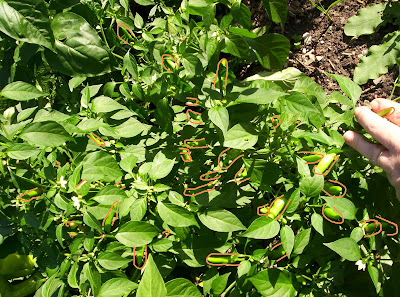 These Super Chili Peppers are VERY PRODIGIOUS PRODUCERS. I outlined all the visible peppers so you could get an idea of how many are in there. There are far more on the lower branches, and as you can see, many many blossoms still. We have three of these plants and I'd say that's two too many for us. I'll donate some to the local food banks and freecycle others. Those we keep I will dry and store for use in stir-fries. We like 'em hot!
These Super Chili Peppers are VERY PRODIGIOUS PRODUCERS. I outlined all the visible peppers so you could get an idea of how many are in there. There are far more on the lower branches, and as you can see, many many blossoms still. We have three of these plants and I'd say that's two too many for us. I'll donate some to the local food banks and freecycle others. Those we keep I will dry and store for use in stir-fries. We like 'em hot!
Our sunflowers this year are ginormous! The landing on my porch is 5 feet from ground level. That's just below the height of the Canna Lilly's bloom. That center sunflower is about 14 feet high! It has numerous blossoms on it that haven't yet opened. I think my sunflowers cross-pollinated last year as these are all from my own seed stock. I had a volunteer Kong sunflower show up in my memorial bed last year -- a gift from a visiting bird. It was about 8 feet tall and had more than 30 blossoms on it. I had also planted Russian Giants which got 6-8 feet tall and had one very large central blossom, nearly a foot across. This year I've got 10 foot sunflowers with multiple blooms, some of them very large, others much smaller. Very interesting. And as you can see, one of my Cannas bloomed! Yay! These are "only" about eight feet tall. The birds love them. To the right is a giant blossom that has been a favourite haunt of the neighborhood birds lately.
These are "only" about eight feet tall. The birds love them. To the right is a giant blossom that has been a favourite haunt of the neighborhood birds lately.
Check out the sunflowers growing through the porch rails. These ones do have pale petals. I don't know why. The birds still think they're good eating. Anyone placing bets on how many volunteer sunflowers I'll have next year? Next year I won't plant them here. I will, if I'm allowed, surround that telephone pole out at the curb with them. That'll make the birds happy! No, I don't harvest the seeds for myself, though I love sunflower seeds. It's just so much darned work! I buy my sunflower seeds already hulled, thank you! I do harvest heads for seed saving, though. Anyone want some?
I'm always amazed by cucumber growth spurts that happen overnight. This thing was about 4 inches long yesterday morning. Then we had some rains in the afternoon and today it's 8 inches long. Amazing! I'll pick it and another will take its place in no time! Hubby's old work boots recycled into hen & chick planters. These were just planted this year, too. Man, those things reproduce fast! I'll have another pair on a lower step next year!
Hubby's old work boots recycled into hen & chick planters. These were just planted this year, too. Man, those things reproduce fast! I'll have another pair on a lower step next year! Check out the beautiful Chinese Lanterns! Wow! They're nice sized, too. I planted these last year and the lanterns averaged about an inch long, one and a half inches around. They're triple that this year! And what great colour! I'll be harvesting these soon. (Trim the stalks, trim away the leaves. Spray the lanterns with hairspray, and hang to dry. They'll retain their colour and make a lovely holiday decoration.)
Check out the beautiful Chinese Lanterns! Wow! They're nice sized, too. I planted these last year and the lanterns averaged about an inch long, one and a half inches around. They're triple that this year! And what great colour! I'll be harvesting these soon. (Trim the stalks, trim away the leaves. Spray the lanterns with hairspray, and hang to dry. They'll retain their colour and make a lovely holiday decoration.) A closeup of some of the lanterns. With my hand there, you can get an idea of how big those lanterns are. Chinese lanterns are invasive and will take over a garden. We planted them in a whiskey barrel to keep them in check. SO far so good. I think it helps that we harvest the lanterns (there is an edible berry inside the lantern, which also contains numerous seeds. The berries are like tiny tomatoes with hundreds of seeds in each.) I don't eat the berries. They taste yucky.
A closeup of some of the lanterns. With my hand there, you can get an idea of how big those lanterns are. Chinese lanterns are invasive and will take over a garden. We planted them in a whiskey barrel to keep them in check. SO far so good. I think it helps that we harvest the lanterns (there is an edible berry inside the lantern, which also contains numerous seeds. The berries are like tiny tomatoes with hundreds of seeds in each.) I don't eat the berries. They taste yucky.
Posted by CannedAm at 8:12 PM 4 comments
Labels: Canna lilly in bloom, chili peppers, Chinese Lanterns, cucumbers, flowers, garden photos beans, giant sunflowers, green bell peppers, raised-bed gardening, rattlesnake beans, vertical gardening
Thursday, August 14, 2008
Winnie in the Sky with.....something that sounds like diamonds

Come on, tell me you cannot see Winnie the Pooh's profile in that big ol' cloud over Lake Ontario.
Not seeing it, eh? How about now? (Man, look at that storm all the way across the lake over....ummmm....errrr.....Burlington (??) I think.)
How about now? (Man, look at that storm all the way across the lake over....ummmm....errrr.....Burlington (??) I think.)
Okay, one more:
Now what's a Winnie the Pooh cloud have to do with gardening?
That cloud and its 18 bazillion buddies has been hanging over Ontario for the past couple of months. They're the reason my maters aren't ripe yet. Come on, give me some more sun.
According to The Weather Network , Ontarian farmers are loving the wet weather. Sure, I lost a couple things to wilt last year from the heat. But Jimminy Crickets...I'd sure like the sun to make more than spot appearances and ripen up my veggies! We in Ontario are literally STUCK in this low pressure system that cannot escape our borders thanks to high pressure systems wedging it in right where it's been the past two-and-a-half months. We're breaking records for rainfall. We beat out previous records for June and July and we're well on our way to beating out records for the whole summer, according to this article also at The Weather Network.
I just want my maters to go from green to red!
And let's please not spend too much time pondering why it is I see Winnie the Pooh in that cloud!
Posted by CannedAm at 3:28 PM 2 comments
Labels: Cloud image, cloud photographs, gardening in the rain, rain rain go away, record rainfall in southern Ontario, weather system in Southern Ontario, Winnie the Pooh Cloud
Monday, August 11, 2008
Monday's Harvest
Click on the pictures to see more detail... A quart or more of green beans (mostly rattlesnake green beans and some French fillet green beans) and about 20 cherry tomatoes (oh, they're SO GOOD!) and a sprig of basil.
A quart or more of green beans (mostly rattlesnake green beans and some French fillet green beans) and about 20 cherry tomatoes (oh, they're SO GOOD!) and a sprig of basil.
Some Hot Banana peppers, two cukes, and one cherry bomb pepper. The peppers are a little under ripe, but that's fine. This is tonight's dinner.
Posted by CannedAm at 7:38 PM 1 comments
Labels: cherry bomb pepper, cherry tomatoes, cucumbers, harvest, hot banana peppers, rattlesnake green beans
Saturday, August 9, 2008
Hot Pepper Harvest
The first of many. This is from only 2 plants. We have 15 (or is it 17...or 20?) more. 
Now some of those peppers didn't pass muster and instead went into the compost bin. ($#$@%#$ing slugs! have been at them....all this !#$!#$ing rain!) With the rest (the bulk of them) hubby canned 3 quarts and 3 pints of hot pepper rings. These aren't extremely hot -- about a 5 on a 1-10, 10 the hottest, scale. He did, however, add habaneros to one jar. Ohhhh....that's gonna be the hot one. Those habaneros make my tongue feel like a laser has sliced through it.
I'll tell you about canning them in an upcoming post on my at home blog.
Posted by CannedAm at 10:05 PM 1 comments
Labels: garden pictures, growing hot peppers, habaneros, hot hungarian wax peppers, pepper harvest, pickled pepper rings
Monday, August 4, 2008
Garden Pictures for the beginning of August
I'll start with the front of the house. This is the first of the beds. I've got Allysum growing in there along with garden oregano, a couple volunteer cherry tomatoes, yellow four-o'clocks, Cannas without blooms (I don't think I'll have any blooms this year as the sunflowers are shading them too much), Autumn Joy Sedum, zinnias and bachelor's buttons, and you can see the rock garden at the front edge of this bed. I overplanted this bed intentionally as it's going to be widened next year and another will be added on the opposite side of the stairs which will be coming down in front instead of on the side as they are now. I'll need to fill those beds in!
Here is the Peach tree we planted out front this year. It's coming along nicely: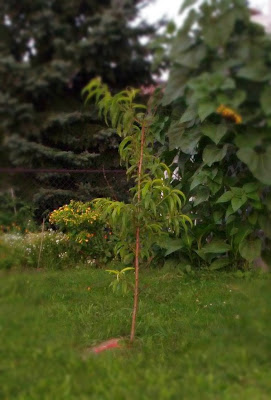
This is the retaining wall we rebuilt this spring. In an upcoming post I'll show you before & after pictures and some of the work in progress. The beds behind the retaining wall were empty. We've planted Black Beauty Elder, Red Spirea, Persian cat mint, Autumn Joy sedum, Pinks (Dianthus), several annuals: salvia, Allysum, a pretty purple flower I can't name (shown after this picture), another that I cannot recall what it was, a couple different petunias (one was killed by the vicious, evil bindweed).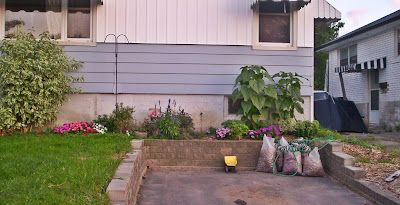
Those pretty purple flowers I cannot name. They're an annual. They were rescued from NoFrills for twenty-five cents apeice. They are lovely and I'd like to grow them again.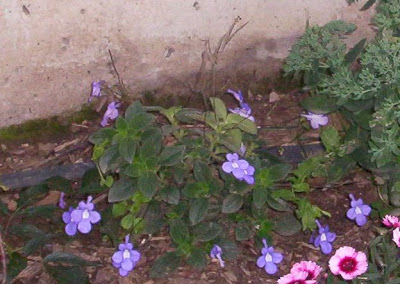
Remember that Ajuga bed I planted this spring? I thought it would take a couple years to completely fill in. It is doing its job of battling the weeds. Some try to poke through, but they're not flourishing, that's for sure! As you can see along the right-hand side of this bed, the neighbor's weeds are flourishing. I believe I'm going to plant his trough out with Ajuga next spring. (That's a lovely blue Hydrangea at the back edge of the Ajuga. It has a twin farther up in the bed whose flowers are pink. They weren't pink when I purchased it. I'll have to see what's up with that.)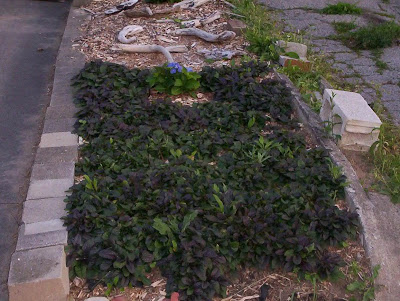
Speaking of weeds....BINDWEED has been the bane of my gardening existence this year. We stirred up its root system when we rebuilt the retaining wall and I am extensively battling it this year. I am having success and I will dedicate another post to the topic. I did, however, lose a petunia to this evil, vile stuff. Take a look at it all over my black beauty elder: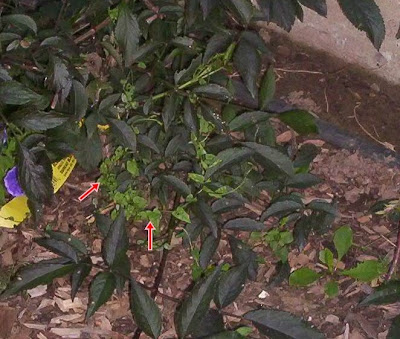 And all over my Lady's Mantle. Yes, my Lady's Mantle looks sickly. It was transplanted in June when the heat was on. It'll come back next year nicely.
And all over my Lady's Mantle. Yes, my Lady's Mantle looks sickly. It was transplanted in June when the heat was on. It'll come back next year nicely.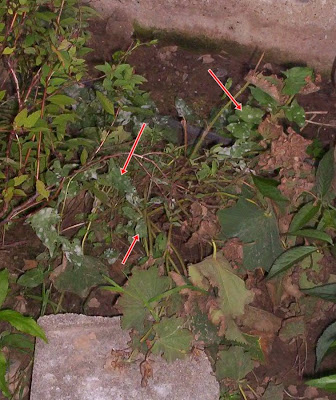
Now we're off to the back yard.....
Would you like a solution for cats who crap in your gardens? One that doesn't involve illegal activities or high-speed projectiles? Our solution is in the next picture. We have Brussell's sprouts in this plot. They were newly planted after the peas finished, but the cats were making us miserable. So we surrounded it and covered the top with bird netting (I know you can't see it in the photo.) Next cat who tries to jump in there is in for a big surprise. Grrrrrr....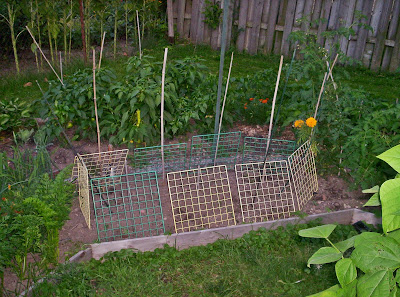 A project in progress. Anyone want to place bets on whether it will be finished this year? I really shouldn't put hubby on to so many projects in one season. He has built me two new raised beds, rebuilt theretaining wall, installed the rocks in the rock garden, cut the barrell for the water garden & also filled it, built the supports for our vertical gardening, built us a rain barrell, and oh my I know I'm probably forgetting a thing or two. So I don't mind if it takes him all summer and part of fall to complete our garbage surround (made from a salvaged gazebo frame .) You can tell it's going to be lovely when he's done (ignore the weeds please):
A project in progress. Anyone want to place bets on whether it will be finished this year? I really shouldn't put hubby on to so many projects in one season. He has built me two new raised beds, rebuilt theretaining wall, installed the rocks in the rock garden, cut the barrell for the water garden & also filled it, built the supports for our vertical gardening, built us a rain barrell, and oh my I know I'm probably forgetting a thing or two. So I don't mind if it takes him all summer and part of fall to complete our garbage surround (made from a salvaged gazebo frame .) You can tell it's going to be lovely when he's done (ignore the weeds please):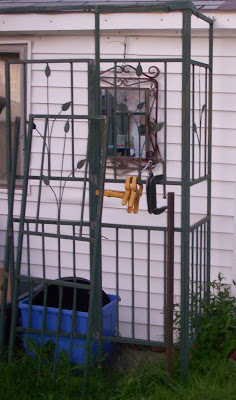
Our Memorial Bed has gone nuts. Some of these plants are growing to be placed into the front beds next year. It's not been a memorial bed this year, it's been a "nursery." The sunflowers are 10 feet tall. The chinese lanterns (contained in a half whiskey barrell) have gone nuts. The daisy overwhelmed my gold mound spirea despite the 18 inches between them. The calendula is crazy and yes, there's another cherry tomato in there too.
The front of the bean tee pee:
The back of the bean tee pee: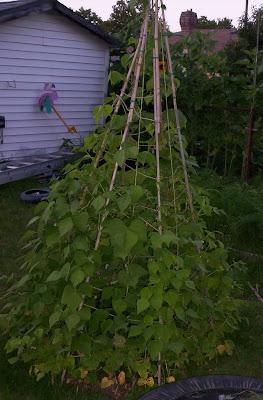
Lots of green tomatoes. These are cherries. Compare them in size to the beefsteak. Yes, the beefsteak are small, but the cherries are HUGE: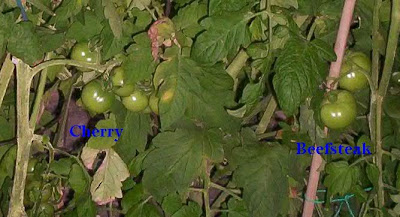
The Romas look nice...GREEN...but nice: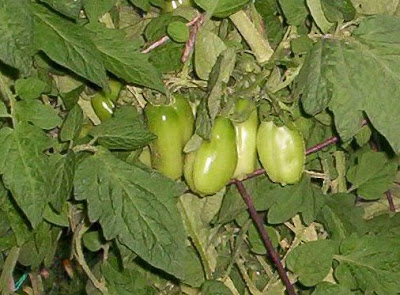
This is part of our pepper patch. Click on the picture to see a larger version. I'm not sure if those rounded ones are cherry bombs or not. Even green, they're still hot:
Oh, and I guess I'll show you one of my gardening failures this year. This planter dries out quite readily. The potting soil I used is not helping this situation. Holes at the bottom drain as soon as water hits the soil. It's ridiculous really. Next year I'll add some stuff to help it retain more moisture. Sorry the picture is so low quality. It's the only one I took, so we're stuck with it.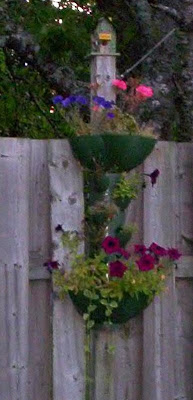
Posted by CannedAm at 11:07 AM 1 comments
Labels: Ajuga, bean tee pee, bindweed, dianthus, garden photos, green tomatoes, growing hot peppers, growing peppers, keep cats out of the garden, petunia, retaining wall, roma tomatoes, wall planter
Sunday, July 20, 2008
Rachel, Rachel, How Does Your Garden Grow?
Well, it grows and grows and grows. In some places it grows almost wild!
If you click on the individual pictures, you'll be able to see a larger version with a bit more detail.
Below is our pepper patch. There are about 30 plants here. We have habaneros, California Wonder, Mini Bells, hot banana, mild banana, hot hungarian, pimiento, carmen, jalepeno, ring of fire, and a couple more, too! Yes, we like peppers. I like the mild ones fresh in our salads or as crudite. We love pickled hot pepper rings, so we'll be canning a good bit of those. We also like the hot ones in stir fries, Mexican dishes, eggs, etc. I'll freeze a good many, can the hot rings, and the rest will be eaten fresh. Yum Yum!
Oh, do you like the path we installed in the garden this year? It was much needed. The garden is too wide to reach the centers from outside and we were trampling the soil something awful last year. So we dug out the center and poured rock to a foot deep running the whole center from one end to the other. 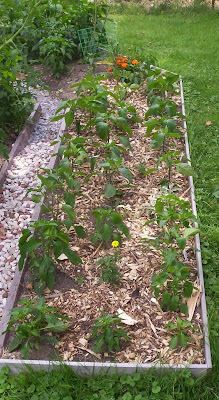
Now look how much bigger the peppers pictured below are than the ones in the first picture. Would you like to venture a guess why they're so much bigger than the others?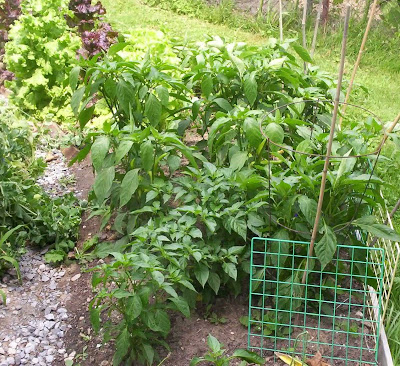 Okay, they were planted a little bit earlier than the others but only a week or so. Early on, the squirrels came by and topped each of these pepper plants. That's right, took the whole top of the plant! I don't know why they do this, but they do this every spring! They'll do it to tomatoes, too. Which is why we built this little surround for the peppers so that they wouldn't take any more of the plants than they already had. Many of the plants were down to two leaves. We didn't think they'd make it. Do you think those squirrels are doing us a favor? It does bear some consideration. In order to have bigger plants that set more fruit, you're supposed to pluck the first blossoms. (This does work, too. The plants in the first picture were deflowered after I took that photo and they're already bushing out.) So perhaps having the squirrels top off our peppers every year is the squirrel's way of giving back. I don't know.
Okay, they were planted a little bit earlier than the others but only a week or so. Early on, the squirrels came by and topped each of these pepper plants. That's right, took the whole top of the plant! I don't know why they do this, but they do this every spring! They'll do it to tomatoes, too. Which is why we built this little surround for the peppers so that they wouldn't take any more of the plants than they already had. Many of the plants were down to two leaves. We didn't think they'd make it. Do you think those squirrels are doing us a favor? It does bear some consideration. In order to have bigger plants that set more fruit, you're supposed to pluck the first blossoms. (This does work, too. The plants in the first picture were deflowered after I took that photo and they're already bushing out.) So perhaps having the squirrels top off our peppers every year is the squirrel's way of giving back. I don't know.
Below is the boys' bean tee-pee. The beans are much bigger now. Today was just too busy to take another picture. I can hardly wait until they're all the way up the tee pee! Notice how richly green the grass is that immediately surrounds the growing beans. Legumes fix nitrogen in the soil ... seems to be working. 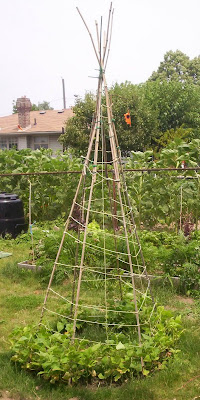 Now I've got to talk about soil. Below is our newest vegetable bed. Isn't it a pathetic thing? I am extraordinarily disappointed in the soil we bought for this box. I am also disappointed in the seeds for my bush beans as only 1 out of 10 germinated. Even after replanting we had the same results. Those are no good. Yet they're from the same company that packaged our vining beans and those did just fine and germinated at about 100%. More about the soil after this picture.
Now I've got to talk about soil. Below is our newest vegetable bed. Isn't it a pathetic thing? I am extraordinarily disappointed in the soil we bought for this box. I am also disappointed in the seeds for my bush beans as only 1 out of 10 germinated. Even after replanting we had the same results. Those are no good. Yet they're from the same company that packaged our vining beans and those did just fine and germinated at about 100%. More about the soil after this picture.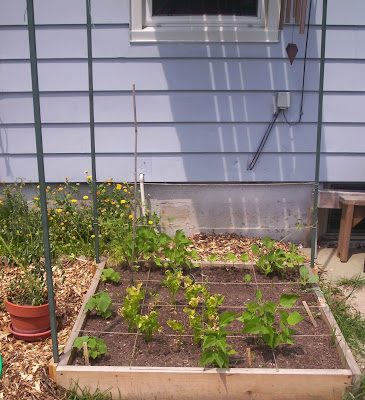
I would recommend the quad mix from Trail's End (that's what's in my other bed, where the peppers are) but they're no longer carrying it. I went with their triple mix this year and I am sorely disappointed in it. Whereas the quad mix drains very well, yet has a high humus content to conserve moisture during the dry spells, this triple mix is lacking. It drains too well. It is dry most of the time. I have ammended it with two different composts and I will be covering it with mulch next week. My plants have been stunted in this material. Things I started from seed barely germinated (most likely because the soil dries out so quickly.) I can completely saturate the soil at night and by mid morning it is extremely dry. This is awful. I think they should take it back next year and tell me where to go for the quad mix!
How about a few flowers:
Calendula: self seeds like mad, but it's good for bug bites and summer-long colour so I like it. (But I am removing the seed heads!)
This is a gorgeous Brown-Eyed Susan. The photo does it no justice. I can't tell you the variety right now because I can't get to the plant tag, it's buried in all the greenery behind it somewhere. It is a type of Rudbeckia, just not sure which one. 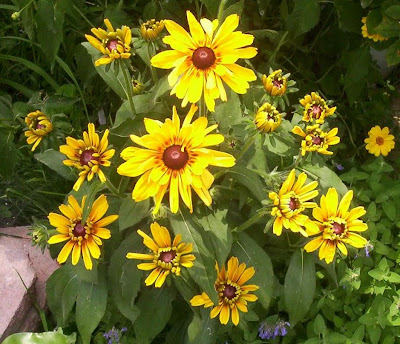
And I have these lovely "Summer Sun" Oxeye Daisies. I just love these. They're a bright yellow, with a yellow center and so cheerful -- covered in flowers all summer long. I'm so pleased with it I'll be splitting it up and moving it into the new beds I'm creating out front next year.
There are a few things in the picture below. I'll try to point them out to you without much confusion. Do you see the yellow-green leaves growing along the ground? That is creeping Jenny. I love the stuff. It's just so lovely. The purple and white clouds of flowers are annual Alyssum, one of my favourite flowers. They have a very sweet scent that wafts across the air with every breeze. The white Alyssum self-seeded from last year. That's okay. It's welcome here. In the background is a nice clump of garden oregano. It's doing quite well for having been transplanted just this spring.That poor solar light. The $1 lights just don't hold up too well. I might have to break the piggy bank and invest in some $2 solar lights.
I'll have some more of the gardens, soon.
Posted by CannedAm at 9:02 PM 2 comments
Labels: bean tee pee, container gardening, flowers, growing peppers, peppers, photos of flowers, raised bed gardening, vegetable gardening





